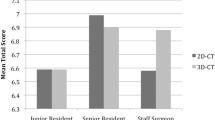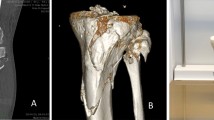Abstract
Purpose
In the present study, we aimed to evaluate the impact of two-dimensional multi-planar computed tomography (2D-MP-CT) scans and three-dimensional surface rendering computed tomography reconstruction (3D-SR-CT) on the inter- and intra-observer reliability of four commonly used classification systems for tibial pilon fractures, and on the reliability and validity of surgical treatment planning for fracture fixation.
Methods
Four observers evaluated computed tomography images of 35 cases with pilon fractures according to the classifications of Rüedi and Allgöwer, AO/OTA, Topliss, and Tang, and recommended a surgical treatment plan, including the surgical approach, implant position, and need for bone graft augmentation. Fractures were first evaluated using 2D-MP-CT, followed by 3D-SR-CT. We calculated the Kappa values for the correlation between the fracture classifications, types of surgical approaches, implant positions, and bone graft recommendations by the observers. Furthermore, we assessed the correlation between the treatment plans recommended by the observers and the actual surgical procedure performed.
Results
All classifications showed poor inter-observer reliability and moderate intra-observer reliability with 2D-MP-CT scans. The inter-observer reliability of the Rüedi and Allgöwer, AO/OTA, and Tang classifications improved to moderate, whereas the intra-observer reliability of the AO/OTA classification improved to good with additional 3D-SR-CT. The correlation between the suggested and the actually performed surgical approaches was poor with 2D-MP-CT, but improved to moderate with 3D-SR-CT. The suggested plate positions showed a moderate correlation with the actually performed plating; although the correlation improved significantly, it remained moderate with 3D-SR-CT.
Conclusion
The use of 3D-SR-CT reconstruction can improve the reliability of the Rüedi and Allgöwer, AO/OTA, and Tang classifications. Furthermore, three-dimensional imaging enables a more valid planning of the surgical approach and implant position.




Similar content being viewed by others
References
Cutillas-Ybarra MB, Lizaur-Utrilla A, Lopez-Prats FA (2015) Prognostic factors of health-related quality of life in patients after tibial plafond fracture. A pilot study. Injury 46(11):2253–2257. https://doi.org/10.1016/j.injury.2015.06.025
De-Las-Heras-Romero J, Lledo-Alvarez AM, Lizaur-Utrilla A, Lopez-Prats FA (2017) Quality of life and prognostic factors after intra-articular tibial pilon fracture. Injury 48(6):1258–1263. https://doi.org/10.1016/j.injury.2017.03.023
Elsoe R, Larsen P, Petruskevicius J, Kold S (2018) Complex tibial fractures are associated with lower social classes and predict early exit from employment and worse patient-reported QOL: a prospective observational study of 46 complex tibial fractures treated with a ring fixator. Strateg Trauma Limb Reconstr 13(1):25–33. https://doi.org/10.1007/s11751-017-0301-y
Stapleton JJ, Zgonis T (2014) Surgical treatment of tibial plafond fractures. Clin Pediatr Med Surg 31(4):547–564. https://doi.org/10.1016/j.cpm.2014.06.002
Tomas-Hernandez J (2016) High-energy pilon fractures management: state of the art. EFORT Open Rev 1(10):354–361. https://doi.org/10.1302/2058-5241.1.000016
Korkmaz A, Ciftdemir M, Ozcan M, Copuroglu C, Saridogan K (2013) The analysis of the variables, affecting outcome in surgically treated tibia pilon fractured patients. Injury 44(10):1270–1274. https://doi.org/10.1016/j.injury.2013.06.016
Sommer C, Nork SE, Graves M, Blauth M, Rudin M, Stoffel K (2017) Quality of fracture reduction assessed by radiological parameters and its influence on functional results in patients with pilon fractures—a prospective multicentre study. Injury 48(12):2853–2863. https://doi.org/10.1016/j.injury.2017.10.031
Ruedi TP, Allgöwer M (1979) The operative treatment of intra-articular fractures of the lower end of the tibia. Clin Orthop Relat Res 138:105–110
Topliss CJ, Jackson M, Atkins RM (2005) Anatomy of pilon fractures of the distal tibia. J Bone Jt Surg Br 87(5):692–697. https://doi.org/10.1302/0301-620X.87B5.15982
Tornetta P 3rd, Gorup J (1996) Axial computed tomography of pilon fractures. Clin Orthop Relat Res 323:273–276
Marsh JL, Slongo TF, Agel J, Broderick JS, Creevey W, DeCoster TA, Prokuski L, Sirkin MS, Ziran B, Henley B, Audige L (2007) Fracture and dislocation classification compendium—2007: orthopaedic Trauma Association classification, database and outcomes committee. J Orthop Trauma 21(10 Suppl):S1–133
Müller M, Nazarian S, Koch P, Schatzker J (1990) The comprehensive classification of fractures of long bones. Springer, Berlin
Tang X, Tang PF, Wang MY, Lu DC, Liu MZ, Liu CJ, Liu Y, Sun LZ, Huang LJ, Yu L, Zhao YG (2012) Pilon fractures: a new classification and therapeutic strategies. Chin Med J (Engl) 125(14):2487–2492
Martin JS, Marsh JL, Bonar SK, DeCoster TA, Found EM, Brandser EA (1997) Assessment of the AO/ASIF fracture classification for the distal tibia. J Orthop Trauma 11(7):477–483
Ramappa M, Bajwa A, Singh A, Mackenney P, Hui A, Port A (2010) Interobserver and intraobserver variations in tibial pilon fracture classification systems. Foot (Edinb) 20(2–3):61–63. https://doi.org/10.1016/j.foot.2010.06.002
Swiontkowski MF, Sands AK, Agel J, Diab M, Schwappach JR, Kreder HJ (1997) Interobserver variation in the AO/OTA fracture classification system for pilon fractures: is there a problem? J Orthop Trauma 11(7):467–470
Brunner A, Honigmann P, Treumann T, Babst R (2009) The impact of stereo-visualisation of three-dimensional CT datasets on the inter- and intraobserver reliability of the AO/OTA and Neer classifications in the assessment of fractures of the proximal humerus. J Bone Jt Surg Br 91(6):766–771. https://doi.org/10.1302/0301-620X.91B6.22109
Doornberg J, Lindenhovius A, Kloen P, Dijk CN, Zurakowski D, Ring D (2006) Two and three-dimensional computed tomography for the classification and management of distal humeral fractures. Evaluation of reliability and diagnostic accuracy. J Bone Jt Surg Am 88(8):1795–1801
Cohen J (1960) A coefficient of agreement for nominal scales. Educ Psycho Meas 20:37–46
Landis JR, Koch GG (1977) The measurement of observer agreement for categorical data. Biometrics 33(1):159–174
Abebe E, Farrell DJ, Zelle B, Gruen G (2017) Primary posterior blade plate tibiotalar arthrodesis: a salvage procedure for complex nonreconstructable pilon fractures. J Orthop Trauma 31(Suppl 3):S30–S33. https://doi.org/10.1097/BOT.0000000000000911
Calori GM, Tagliabue L, Mazza E, de Bellis U, Pierannunzii L, Marelli BM, Colombo M, Albisetti W (2010) Tibial pilon fractures: which method of treatment? Injury 41(11):1183–1190. https://doi.org/10.1016/j.injury.2010.08.041
Ovadia DN, Beals RK (1986) Fractures of the tibial plafond. J Bone Jt Surg Am 68(4):543–551
Blauth M, Bastian L, Krettek C, Knop C, Evans S (2001) Surgical options for the treatment of severe tibial pilon fractures: a study of three techniques. J Orthop Trauma 15(3):153–160
Brunner A, Heeren N, Albrecht F, Hahn M, Ulmar B, Babst R (2012) Effect of three-dimensional computed tomography reconstructions on reliability. Foot Ankle Int 33(9):727–733. https://doi.org/10.3113/FAI.2012.0727
Brunner A, Horisberger M, Ulmar B, Hoffmann A, Babst R (2010) Classification systems for tibial plateau fractures; does computed tomography scanning improve their reliability? Injury 41(2):173–178. https://doi.org/10.1016/j.injury.2009.08.016
Acknowledgements
Special thanks to Sarah Reiter for providing the great drawings.
Author information
Authors and Affiliations
Corresponding author
Ethics declarations
Conflict of interest
All authors declare that they have no conflict of interest.
Additional information
Publisher's Note
Springer Nature remains neutral with regard to jurisdictional claims in published maps and institutional affiliations.
Rights and permissions
About this article
Cite this article
Keiler, A., Riechelmann, F., Thöni, M. et al. Three-dimensional computed tomography reconstruction improves the reliability of tibial pilon fracture classification and preoperative surgical planning. Arch Orthop Trauma Surg 140, 187–195 (2020). https://doi.org/10.1007/s00402-019-03259-8
Received:
Published:
Issue Date:
DOI: https://doi.org/10.1007/s00402-019-03259-8




